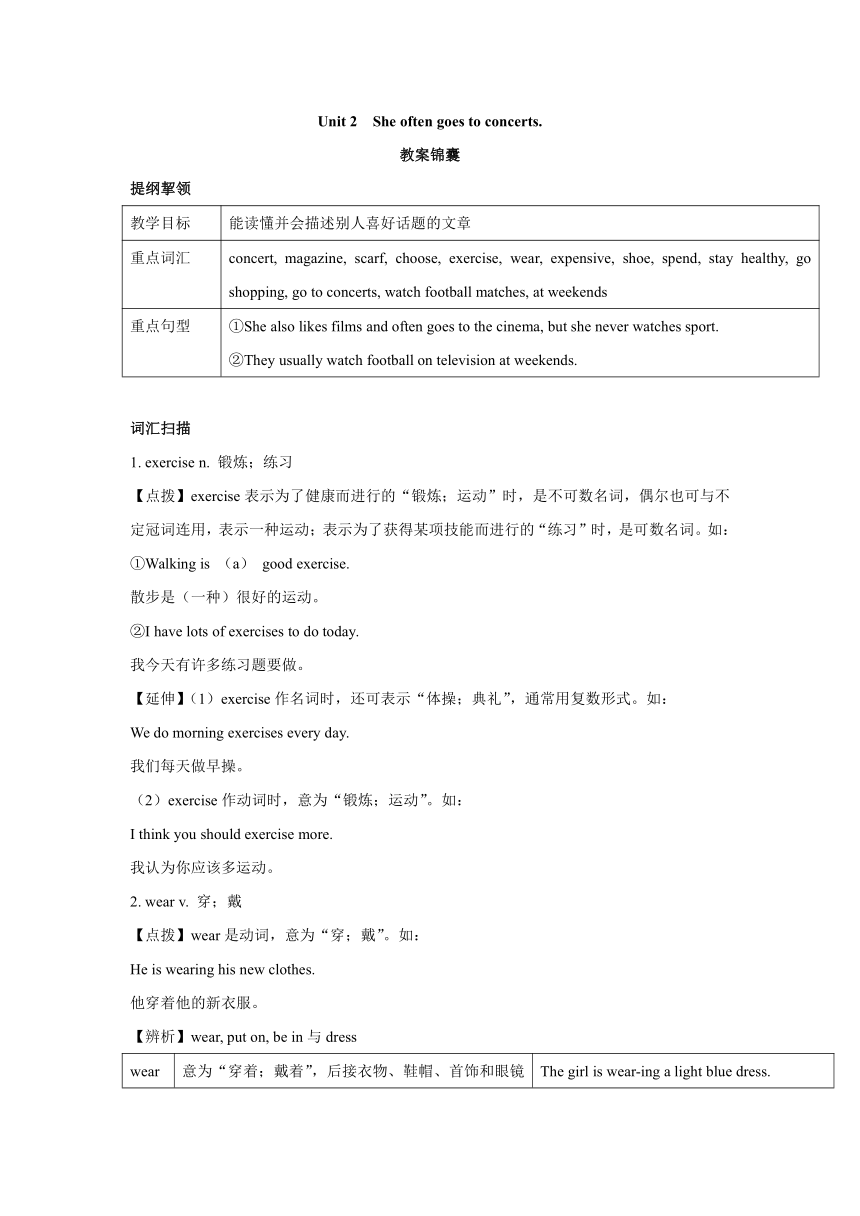
Unit 2 She often goes to concerts. 教案锦囊 提纲挈领 教学目标 能读懂并会描述别人喜好话题的文章 重点词汇 concert, magazine, scarf, choose, exercise, wear, expensive, shoe, spend, stay healthy, go shopping, go to concerts, watch football matches, at weekends 重点句型 ①She also likes films and often goes to the cinema, but she never watches sport.②They usually watch football on television at weekends. 词汇扫描 1. exercise n. 锻炼;练习 【点拨】exercise表示为了健康而进行的“锻炼;运动”时,是不可数名词,偶尔也可与不定冠词连用,表示一种运动;表示为了获得某项技能而进行的“练习”时,是可数名词。如: ①Walking is (a) good exercise. 散步是(一种)很好的运动。 ②I have lots of exercises to do today. 我今天有许多练习题要做。 【延伸】(1)exercise作名词时,还可表示“体操;典礼”,通常用复数形式。如: We do morning exercises every day. 我们每天做早操。 (2)exercise作动词时,意为“锻炼;运动”。如: I think you should exercise more. 我认为你应该多运动。 2. wear v. 穿;戴 【点拨】wear是动词,意为“穿;戴”。如: He is wearing his new clothes. 他穿着他的新衣服。 【辨析】wear, put on, be in与dress wear 意为“穿着;戴着”,后接衣物、鞋帽、首饰和眼镜等作宾语,强调穿着、戴着的状态,可用于进行时 The girl is wear-ing a light blue dress. 这个女孩穿着一条浅蓝色的连衣裙。 put on 意为“穿上;戴上”,指穿衣、穿鞋、戴帽等,侧重于穿、戴的动作 She puts on her coat and goes out.她穿上大衣出去了。 be in 也表示“穿着”的状态,其后接表颜色的名词或服装类名词 He is in blue to-day. 他今天穿着蓝色的衣服。 dress 意为“给……穿衣”,侧重于穿、戴的动作,但后面跟的宾语是人 Tom is too young to dress himself. 汤姆太小了而不会自己穿衣服。 3. at weekends在周末 【点拨】at weekends意为“在周末”。如: Those boys often play basketball at weekends. 那些男孩经常在周末打篮球。 4. write down记下;写下 【点拨】write down意为“记下;写下”。如: This is the address. Do you want to write it down 这是地址,你要不要记下来? 5. hear from收到……的来信 【点拨】hear from意为“收到……的来信”。如: Mary has many friends around the world. She often hears from them. 玛丽在全球有很多朋友。她经常收到他们的来信。 句型透视 1. Daming’s grandparents like to stay healthy... 大明的祖父母想要保持健康…… 【点拨】(1)Daming’s表示“大明的”,为名词所有格形式,一般在名词后加’s,表示所属关系。如: This is Lingling’s room. 这是玲玲的房间。 【延伸】名词所有格表示人或物的所有及所属关系,在句中常作定语。其构成规则如下: 1)单数名词和不以s结尾的复数名词,在词尾加’s。如: my father’s book我爸爸的书 the children’s teacher孩子们的老师 2)以s或es结尾的复数名词只在词尾加“’”。如: our teachers’ office我们老师的办公室 3)表示两者或两者以上共同拥有时,只在最后一个名词后加’s;表示各自拥有时,则在每个名词后面都加’s。如: Mike and Tom’s room 迈克和汤姆共同的房间 Mike’s and Tom’s rooms 迈克的房间和汤姆的房间 4)表示无生命的东西的名词所有格一般用of的介词短语表示,有时有生命的东西也可用of所有格形式,且这种形式可与“名词+’s”所有格形式替换。如: a photo of my family我的全家福 the name of the boy=the boy’s name那个男 ... ...
~~ 您好,已阅读到文档的结尾了 ~~